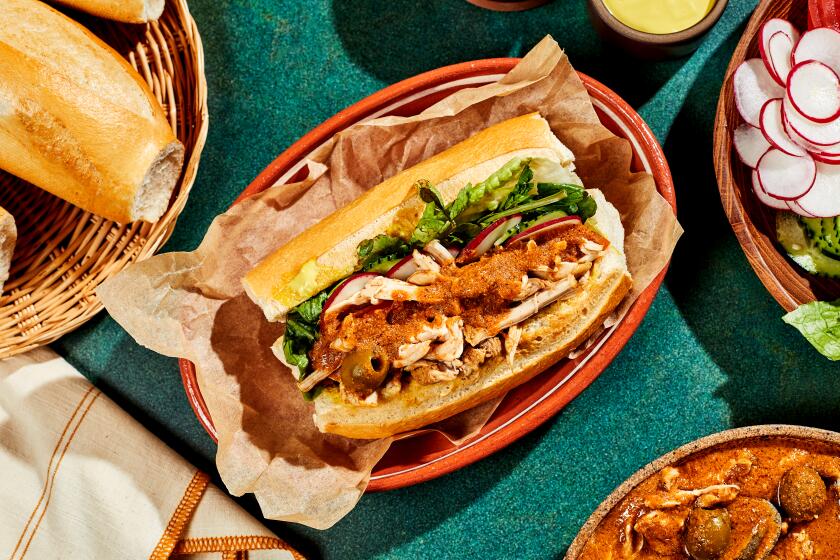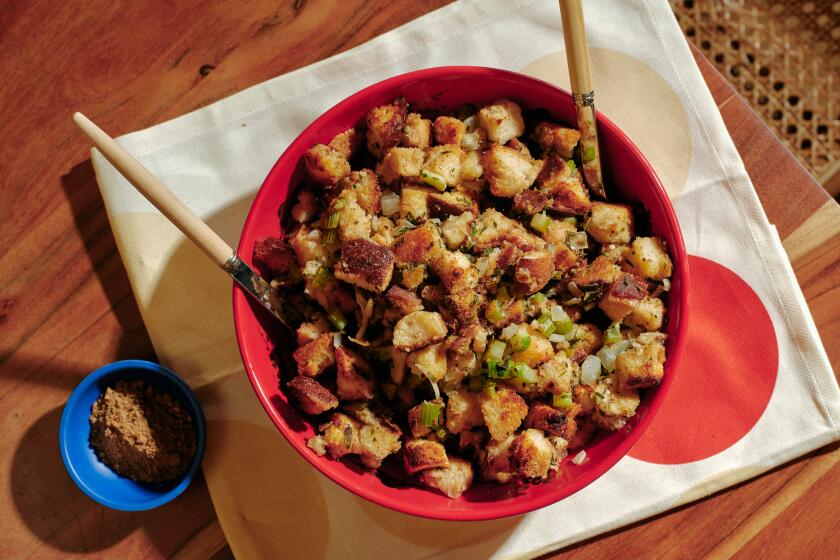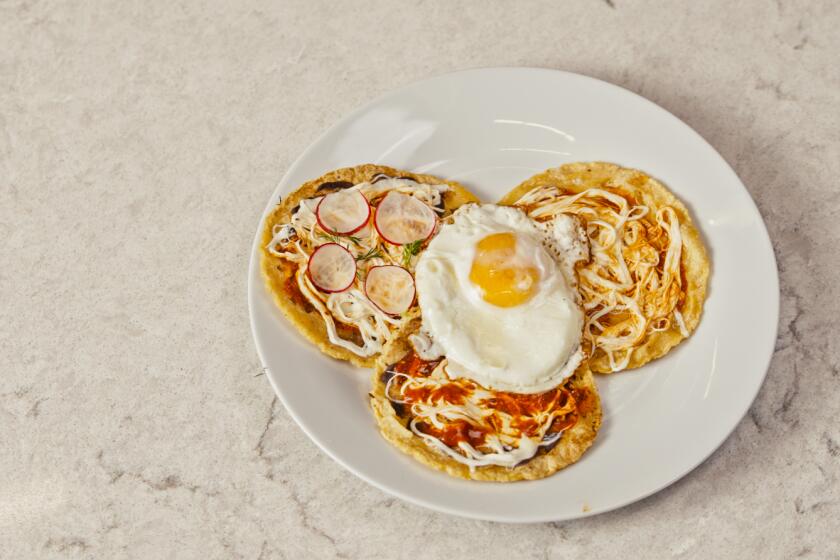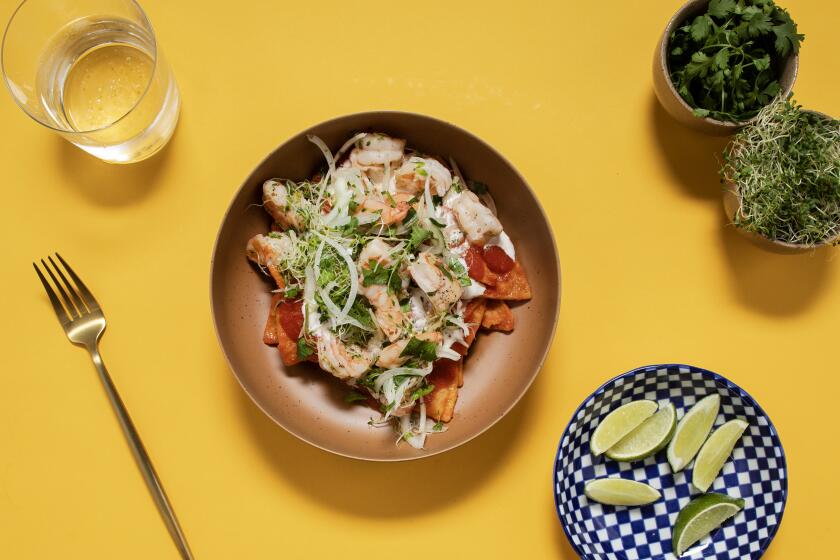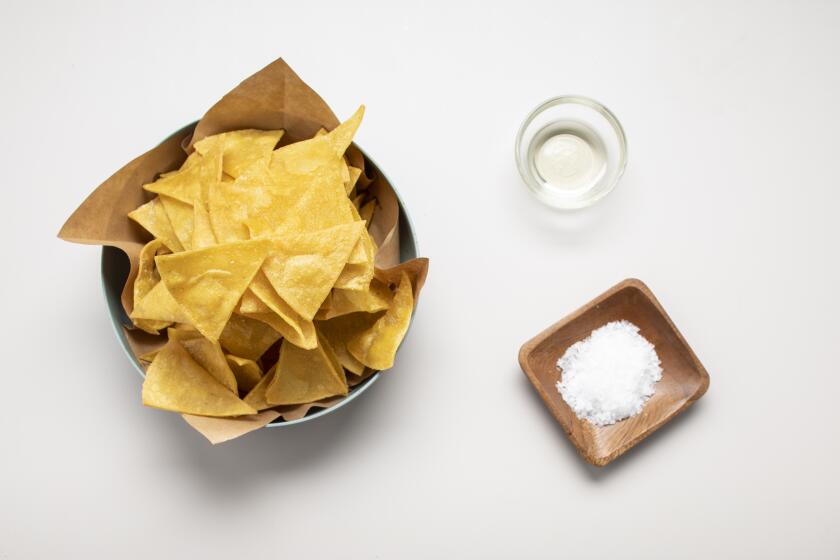Wheat-free muffins
Life in the kitchen can be a real grind -- and, in this case, that’s a good thing.
By grinding your own whole-grain flour, you open the door to a new world of tastes and textures, with the added benefit of creating more healthful treats and meals.
While there are nutritional benefits galore in whole grains, flavor -- and lots of it -- is the biggest plus. Even simple whole-wheat pancakes seem new and surprising when made with freshly ground flour.
“Just about any grain can be ground into flour, and each has its own distinct personality and flavor,” writes Mollie Katzen in “Sunlight Cafe,” her cookbook filled with breakfast-friendly recipes, including terrific wheat-free muffins made from rice flour, millet flour and oat flour, all easily ground at home.
Right about now you may be rolling your eyes, thinking: Who has time for this? But the truth is, the most time-consuming part of making your own flour is choosing the mill best suited for your needs. Do you want the hands-on experience of a small, manually operated grinder? Or would you prefer the ease of a larger electric machine? Once you have a good grain mill in your kitchen, producing flour takes mere minutes.
You’ll quickly discover it’s fun to experiment. Who knew roasted buckwheat could be coarsely ground and turned into polenta? And how about transforming dry corn kernels (also known as popcorn) into cornmeal, which adds a nice texture to pizza dough?
A choice to make
When it comes to grinders, there’s no question an electric mill is more efficient, able to produce a lot of flour in a short amount of time. But remember that this is a serious appliance, big enough that you’ll have to keep it on the counter. It’s also a lot more expensive -- more than $400, compared with less than $100 for most manual mills.
A hand grinder is a much smaller tool you can store unassembled in a drawer or cupboard, taking it out when you need a few cups of flour. It’s a kick to use, in a “Little House on the Prairie” way, but it does require some strength to operate (a plus is that it will tone your upper arms). It also may become a favorite family activity; any kids in the vicinity will want to help out when you start turning the handle.
It can even turn into a business, as it did for brothers Stephen and Ben Gordon, co-owners of the Bicycle Bread Co. Their volunteer-run business sells freshly baked bread to the neighborhoods near the USC campus.
The Gordon brothers and their nine siblings grew up in a house in Gainesville, Fla., where commercial flour was never purchased. Instead, their mother ground her own whole-grain bread flour weekly for her large family.
“My mom is very frugal and very healthy.... She taught all of us kids to bake bread,” says Stephen, 25, who started the Bicycle Bread Co. after graduating from USC in 2008.
Stephen’s graduation presents from his parents were a grinder and a mixer. These tools, and a desire to serve the community near campus, inspired him to start baking bread with his brother Ben, 20, an undergraduate at USC.
“I really wanted to stay in the neighborhood and find a way to be a part of it. I thought, hey, maybe this could be a cool way to start a business which would ultimately serve fresh bread and fresh food in an area that a lot of times doesn’t have healthy options,” says Stephen.
The Gordon brothers grind hard white wheat berries into 100 pounds of flour each week, which is turned into 150 loaves of different varieties of bread, including seasonal favorites. Neither Gordon brother owns a car, so deliveries are made on campus by bicycle. Loaves also are sold Thursdays on two street corners in South Los Angeles, and they’ve just started selling Monday through Friday evenings at their bakery at 1840 S. Union Ave. (For more information, check out their website, www.bicyclebread .com.)
A flight from white
Like the Gordons, many bakers are moving away from refined white flour because they are turned off by the traditional commercial milling process, in which wheat berries are stripped of the nutrient-rich bran and germ.
Award-winning baker Craig Ponsford, former chairman of the Bread Bakers Guild of America, compares white flour to Humpty Dumpty: “It’s a deconstructed food, and then we put it back together. But we don’t put it back together very well.”
He adds that most of the whole-wheat flour sold in grocery stores is actually white flour to which the bran, but not the germ, has been added back. He points out that many people will reject baked goods made from commercial whole-wheat flour because it is dry, dense and bitter. In contrast, freshly milled whole-wheat flour usually has a sweeter taste. And the grinding process itself aerates and sifts the flour, making the texture lighter.
Ponsford explains: “The tastiest part of the wheat berry is the germ; that’s where all the fat is. When you remove all the fat ... it doesn’t have all its properties and it doesn’t taste good. With the germ, with what you guys are doing at home, it’s super-duper tasty. And incredibly more healthful than the flour that’s available at the grocery store.”
Crumb Topping
Using your hands, a large fork or a pastry cutter, mix the butter with the sugar and rice flour. The mixture will be moist and crumbly. Set aside.
Muffins
Heat the oven to 375 degrees. Put 10 paper liners into a standard muffin pan.
In a large bowl, whisk together the rice, millet and oat flours, along with the salt and baking powder.
In a 2-cup measuring cup, combine the maple syrup, egg and enough milk for the combined ingredients to measure 1 cup, about one-fourth cup milk. Add the vanilla and gently whisk with a fork until fully combined.
Pour the wet ingredients into the large bowl with the dry ingredients, stirring with a wooden spoon or a whisk. Add the melted butter and stir just to combine, careful not to overmix. (Don’t worry if there are small lumps.)
Fill the muffin cups with the batter and sprinkle 1 tablespoon Crumb Topping on each muffin. Bake until the muffins are set and a toothpick inserted comes out clean, about 14 minutes.
Get our Cooking newsletter.
Your roundup of inspiring recipes and kitchen tricks.
You may occasionally receive promotional content from the Los Angeles Times.










